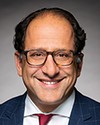Thank you, Mr. Chair and committee members.
It's a double pleasure to be here today because I'm here for twice the usual length of time, two hours. I'm very happy to be with you this afternoon.
I'm very pleased to be joined also by my officials: Marta Morgan, deputy minister, as well as Robert Orr, Dawn Edlund, David Manicom, and Daniel Mills. I think we will probably be sharing the questions, depending on what you choose to ask.
Mr. Chair, I'm glad to be able to provide you with an update on my department’s 2017 immigration levels plan, which we announced last month. This is the second levels plan that I've had the honour of presenting as Minister of Immigration, Refugees and Citizenship. I'm proud of how it reflects our government's commitment to help strengthen our compassionate, open and welcoming country through the immigration system.
The plan will do so by bolstering the middle class through economic growth; attracting investment; supporting diversity; and helping to build vibrant, dynamic and inclusive communities across Canada.
The 2016 plan contained the highest number of projected immigrant admissions put forth by the Government of Canada in modern times, a notable increase from the annual planning range that was in place in recent years.
Our latest plan maintains these historically high levels and will result in Canada welcoming between 280,000 and 320,000 new permanent residents in 2017 across our economic family and refugee programs.
We're also establishing 300,000 as our new baseline for permanent resident admissions in our annual levels planning going forward. This will be the foundation from which we can grow immigration levels in the future.
The 2017 plan balances our economic needs with our commitments to reunite families and offer protection to those in need.
Mr. Chair, we remain strongly committed to the idea that immigration is crucial to Canada's future. We are increasing the share of economic admissions in the 2017 levels plan as compared with the 2016 plan.
Within the overall target of our latest plan, our admissions target in the economic class has been set at 172,500, including 73,700 federal economic admissions, 51,000 provincial nominees, 18,000 admissions through the federal caregivers program, 500 federal business admissions, and the remaining 29,300 admissions coming through the Quebec skilled workers and business program.
The plan restores federal economic admissions above the 2015 level of 70,000 and provides more admission space for candidates selected through our express entry system.
As well, admissions for the new Atlantic immigration pilot program are included in the federal economic category and will accommodate admissions resulting from up to 2,000 applications in 2017. This pilot, which was developed in partnership with the four Atlantic provinces and is expected to launch early next year, aims to attract and retain immigrants to meet the demographic and labour market objectives of these provinces.
One more thing worth highlighting in the economic class is the fact that the 2017 plan will see the virtual elimination of our inventory of legacy live-in caregiver applications with a target of 18,000 admissions through the federal caregiver program by the end of 2019.
The 2017 immigration levels plan also reflects our government's emphasis on family reunification, which helps newcomers better integrate into our country and contribute to their new communities.
We continue to focus on reuniting close family members who, in many cases, are kept apart by processing times that are simply too long.
With that in mind, we're increasing family class admissions by 4,000 spaces, from 80,000 in 2016 to 84,000 in 2017, and by 16,000—or an increase of 24%—as compared to the 2015 plan. Our target of 84,000 family class admissions in 2017 will immediately reduce inventories and processing times.
More levels space combined with targeted efforts to decrease processing times in the spousal category will lead to families being reunited more quickly, so they can start building their lives in Canada. In the case of the parents and grandparents program, we have formally increased the number of entry applications that will be accepted annually. Beginning this year, the number of applications accepted for intake is 10,000, doubling the previous cap of 5,000 applications. We have also continued efforts to reduce the backlog inventory in the parent and grandparent program. We estimate that this inventory will be reduced to 46,000 by the end of 2016, down from a peak of more than 165,000 in 2011.
Mr. Chair, our 2017 immigration levels plan also upholds Canada's long humanitarian tradition of welcoming people seeking refuge and protection from conflict and war. The 2017 target for refugees and protected persons is 40,000, which is divided between a target of 25,000 for our various resettlement programs and 15,000 for our protected persons. The 25,000 resettled refugee admissions include targets of 16,000 privately sponsored refugees, 7,500 government-assisted refugees, and 1,500 blended visa office-referred refugees, sometimes known as BVOR. These numbers uphold Canada's position as a global leader in resettling refugees.
Although the planned refugee admissions are lower than in 2016, which saw our exceptional response to the Syrian refugee crisis, they are considerably higher than the average of 14,000 annual admissions between 2010 and 2015. By setting a target of 16,000 privately sponsored refugee admissions in 2017, the plan will address backlog reduction in applications for that program, reflecting the generosity of Canadians. The 2017 immigration levels plan also includes space for 2,900 to 4,500 admissions in the “humanitarian and other” line of business, which includes admissions of people under humanitarian and compassionate considerations, and on public policy grounds.
We carried out a comprehensive stakeholder and public engagement exercise throughout this past summer.
We found broad support among stakeholders for higher levels, as long as the growth is planned and phased, and accompanied by settlement supports.
Among the general public, the views are a little more mixed, although I'm happy to report that support for immigration remains high.
Mr. Chair, in the remainder of my opening remarks, I will address the main points of supplementary estimates (B). A key component of the mandate letter I received upon becoming minister last year was our government's initiative to welcome 25,000 Syrian refugees within a few months. I am proud that to date we have exceeded our original target and have welcomed over 35,000 Syrian refugees in over 320 communities across the country. But we still have work to do to meet our commitments, and the supplementary estimates reflect this.
For instance, our estimates contain an increase of $7.3 million related to the Syrian refugee initiative. This funding is for the travel costs of 3,040 privately sponsored Syrian refugees, and it's from the amount that was lapsed for this initiative in 2015-16. Therefore, this does not represent an amount above the overall funding already announced for this initiative. This funding will also process the surplus government-assisted refugee applications that were received and in the inventory between February 29 and March 31, 2016. It is expected that those remaining cases are more complex and thus require more resources to finalize. The estimates also contain a $310,000 transfer to the Social Sciences and Humanities Research Council to fund researchers actively engaged in research in areas related to immigration and refugee resettlement. It is intended to support researchers addressing pressing, short-term research issues related to the current Syrian refugee resettlement effort.
This research will inform and support the efforts of policy-makers, service organizations, and other stakeholders.
Another key element of these supplementary estimates is $2.1 million in additional funding for the expansion of the electronic travel authorization, or eTA, for low-risk travellers. This funding will help lift the visa requirement for certain low-risk travellers who are from key visa-required markets and who travel to Canada by air.
As the committee is aware, starting November 10, 2016, visa-exempt foreign nationals—other than U.S. citizens—need an eTA to board their flight to Canada. The eTA allows Canada to screen travellers for admissibility before they travel to Canada and prevent those who are inadmissible from travelling to Canada in the first place.
To date, more than 2.4 million eTAs have been issued. Most—more than 80 %—have been issued within three minutes of the application being submitted.
As my department recently announced, Canada intends to lift the visa requirements for Romanian and Bulgarian citizens on December 1, 2017. In the lead-up to full visa lifts, Canada intends to implement partial lifts for eligible Romanian and Bulgarian travellers. This would mean that on May 1, 2017, Romanian and Bulgarian citizens who have held a Canadian temporary resident visa in the past 10 years or who currently hold a valid United States non-immigrant visa may be eligible to apply for an ETA, or electronic travel authorization, instead of a visa to fly to or transit through Canada.
Mr. Chair, there are other pieces to our supplementary estimates as well, but I think that ends my opening remarks. I'd be very happy to answer any questions you may have.
Thank you.




